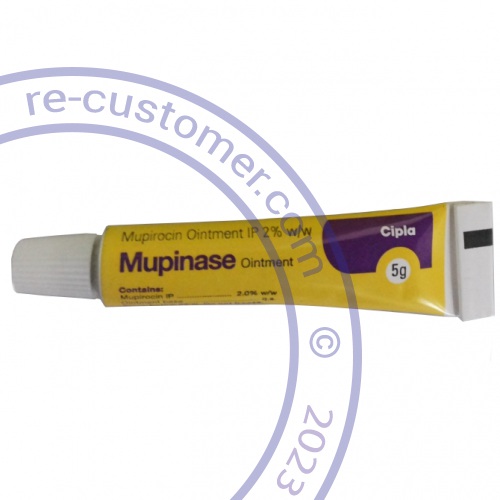- Trusted Tablets
- Skin Care
- Bactroban

Brand(s): Mupinase
Manufacturer: Cipla Limited
Disease(s): Skin Infections
| Package | Price | Per tube | Savings | Order |
|---|---|---|---|---|
| 2% 5g × 4 tubes | $ 99.95 | $ 24.99 | $ 39.95 | Add to cart |
| 2% 5g × 2 tubes | $ 69.95 | $ 34.98 | Add to cart |
Mupirocin topical
What is this medicine?
MUPIROCIN is an antibiotic that prevents bacteria from growing on your skin. Mupirocin topical (for use on the skin) is used to treat skin infections such as impetigo or a "Staph" infection of the skin. Mupirocin topical may also be used for purposes not listed in this medication guide.
What should my health care professional know before I take this medicine?
You should not use this medicine if you are allergic to mupirocin.
Do not use mupirocin topical on a child without medical advice. The cream should not be used on a child younger than 3 months old. The ointment may be used on a child as young as 2 months old.
It is not known whether this medicine will harm an unborn baby. Tell your doctor if you are pregnant or plan to become pregnant.
It is not known whether mupirocin topical passes into breast milk or if it could harm a nursing baby. Tell your doctor if you are breast-feeding a baby.
How should I use this medicine?
Follow all directions on your prescription label. Do not use this medicine in larger or smaller amounts or for longer than recommended.
Do not take by mouth. Mupirocin topical is for use only on the skin. If this medicine gets in your eyes, nose, or mouth, rinse with water.
Wash your hands before and after applying mupirocin topical.
Clean and dry the affected skin area. Use a cotton swab or gauze pad to apply a small amount of mupirocin topical as directed.
Do not spread mupirocin topical over large areas of skin.
Use only a sterile gauze pad to cover the treated skin. Do not cover treated areas with a bandage, plastic wrap, or other covering that does not allow air to circulate.
Mupirocin topical is usually applied 3 times per day for 10 days. Call your doctor if your symptoms do not improve within 3 to 5 days, or if your skin condition gets worse.
Use this medicine for the full prescribed length of time. Your symptoms may improve before the infection is completely cleared. Skipping doses may also increase your risk of further infection that is resistant to antibiotics.
Store at room temperature away from moisture and heat. Do not freeze. Keep the medicine tube tightly closed when not in use.
What if I miss a dose?
Apply the missed dose as soon as you remember. Skip the missed dose if it is almost time for your next dose. Do not use extra medicine to make up the missed dose.
What may interact with this medicine?
It is not likely that other drugs you take orally or inject will have an effect on topically applied mupirocin. But many drugs can interact with each other. Tell each of your health care providers about all medicines you use, including prescription and over-the-counter medicines, vitamins, and herbal products.
What should I watch for while taking this medicine?
Antibiotic medicines can cause diarrhea, which may be a sign of a new infection. If you have diarrhea that is watery or bloody, call your doctor. Do not use anti-diarrhea medicine unless your doctor tells you to.
Avoid getting this medicine in your eyes, mouth, or nose. A separate product called mupirocin nasal is made for use in the nose. Mupirocin topical is for use only on the skin.
Avoid using other medications on the areas you treat with mupirocin topical unless your doctor tells you to.
What side effects may I notice from this medicine?
Get emergency medical help if you have signs of an allergic reaction: hives; difficult breathing; swelling of your face, lips, tongue, or throat.
Call your doctor at once if you have:
-
severe stomach pain, diarrhea that is watery or bloody;
-
redness, itching, dryness, or other irritation of treated skin;
-
unusual skin blistering or peeling; or
-
any signs of a new skin infection.
Common side effects may include:
-
rash;
-
nausea; or
-
headache.
This is not a complete list of side effects and others may occur.
Where can I keep my medicine?
Store at room temperature away from moisture and heat. Do not freeze. Keep the medicine tube tightly closed when not in use.

Can i help you?



